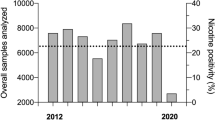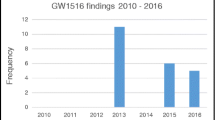Abstract
Background
Urine sample collection for doping control tests is a key component of the World Anti-Doping Agency’s fight against doping in sport. However, a substantial number of athletes experience difficulty when having to urinate under supervision. Furthermore, it cannot always be ensured that athletes are actually delivering their own urine. A method that can be used to alleviate the negative impact of a supervised urination procedure and which can also identify urine as coming from a specific athlete is the urine marker test. Monodisperse low molecular weight polyethylene glycols (PEGs) are given orally prior to urination. Urine samples can be traced to the donor by analysis of the PEGs previously given.
Objective
The objective of this study was to investigate the use of the urine marker during urine doping control testing.
Methods
Two studies investigated athletes’ acceptance of this new method via two questionnaires (n = 253). Furthermore, a third study (n = 91) investigated whether ingestion of the marker can identify the urine as coming from a specific person and whether the marker interferes with the detection of prohibited substances.
Results and conclusions
The results indicate that this new method finds wide acceptance both from athletes who have only heard about the procedure and those who have actually tested the new method. Furthermore, the marker, which can identify urine as coming from a specific person, does not interfere with the detection of prohibited substances.

Similar content being viewed by others
References
WADA in 2011. World Anti-Doping Agency. Compliance Report. Montreal; 2011. http://www.wada-ama.org/en/World-Anti-Doping-Program/Sports-and-Anti-Doping-Organizations/The-Code/Code-Compliance–Reporting/Compliance-Report—Nov—2011/. Accessed 1 Jun 2013.
Corrigan B, Kazlauskas R. Drug testing at the Sydney Olympics. Med J Aust. 2000;173:312–3.
WADA in 2014. World Anti-Doping Agency. International Standard for Testing and Investigations (ISTI). Version 6.0. Montreal; 2014. https://wada-main-prod.s3.amazonaws.com/resources/files/wada_guidelines_urine_sample_collection_2014_v1.0_en.pdf. Accessed 4 Mar 2015.
Sharma R. Daily Mail in 2013. Mail online. London; 2013. http://www.dailymail.co.uk/sport/football/article-2313999/Gerard-Pique-misses-Barcelona-flight-home-drug-test-took-long.html. Assessed 4 Mar 2015.
Strahler K, Elbe AM. Wollen—aber nicht können: das problem dopingkontrolle. Leistungssport. 2007;37(4):35–8.
Elbe AM, Overbye M. Urine doping controls: the athletes’ perspective. Int J Sport Policy Politics. 2014;6(2):227–240.
Elbe AM, Overbye M. Implications of anti-doping regulations for athletes’ wellbeing. In: Hoberman J, Waddington I, Møller V. The Routledge companion to sport and drugs. New York: Routledge International Handbooks; 2015. p. 322–336.
Elbe AM, Schlegel MM, Brand R. Psychogenic urine retention during doping controls: consequences for elite athletes. Perform Enhanc Health. 2012;1(2):66–74.
Strahler K, Elbe AM. Entwicklung einer Skala zur Erfassung psychogenen Harnverhaltens bei Athletinnen und Athleten während der Dopingkontrollen. Z Sportpsychol. 2009;16(4):156–60.
Kellmann M. Underrecovery and overtraining: different concepts—similar impact? In: Kellmann M, editor. Enhancing recovery: preventing underperformance in athletes. Champaign IL: Human Kinetics; 2002. p. 3–24.
Williams GW, Degenhardt ET. Paruresis: a survey of a disorder of micturition. J Gen Psych. 1954;51(1):19–29.
Soifer S, Himle J, Walsh K. Paruresis (shy bladder syndrome): a cognitive-behavioral treatment approach. Soc Work Health Care. 2010;49(5):494–507.
Gauchel G, Huppertz B, Feiertag H, et al. Clinical use of polyethylene glycols as marker substances and determination in urine by liquid chromatography. J Chromatogr B Analyt Technol Biomed Life Sci. 2003;787(2):271–9.
Huppertz B, Gauchel G, Feiertag H, et al. Urine labeling with orally applied marker substances in drug substitution therapy. Clin Chem Lab Med. 2004;42(6):621–6.
Punitha H. Medindia in 2008. Chennai; 2008. http://www.medindia.net/news/Now-a-Fake-Penis-That-Deceives-Drug-Testers-38376-1.htm. Accessed 4 Mar 2015.
Mottram DR. Drugs in sport. 5th ed. London: Routledge; 2011.
Alaranta A, Alaranta H, Holmila J, et al. Self-reported attitudes of elite athletes towards doping: differences between type of sport. Int J Sports Med. 2006;27(10):842–6.
Langman LJ, Snozek CLH. LC-MS in drug analysis: methods and protocols, methods in molecular biology, vol. 902. Rochester: Humana Press; 2012. p. 115–28.
Acknowledgments
This study was financially supported by Partnership for Clean Competition. We would like to thank Nadine Debois and Alain Frey (both INSEP) for their help in the data collection for study 1.
Author information
Authors and Affiliations
Corresponding author
Ethics declarations
Conflict of interest
Ruprecht Keller, Anne-Marie Elbe, and Anthony W. Butch received a grant from Partnership for Clean Competition entitled “A new labelling procedure which allows to identify urine as coming from a particular person.”
Stine Nylansted Jensen, Peter Elsborg, Monika Wetzke, Getachew A. Woldemariam, and Bernd Huppertz declare that they have no conflict of interest.
Rights and permissions
About this article
Cite this article
Elbe, AM., Jensen, S.N., Elsborg, P. et al. The Urine Marker Test: An Alternative Approach to Supervised Urine Collection for Doping Control. Sports Med 46, 15–22 (2016). https://doi.org/10.1007/s40279-015-0388-6
Published:
Issue Date:
DOI: https://doi.org/10.1007/s40279-015-0388-6




